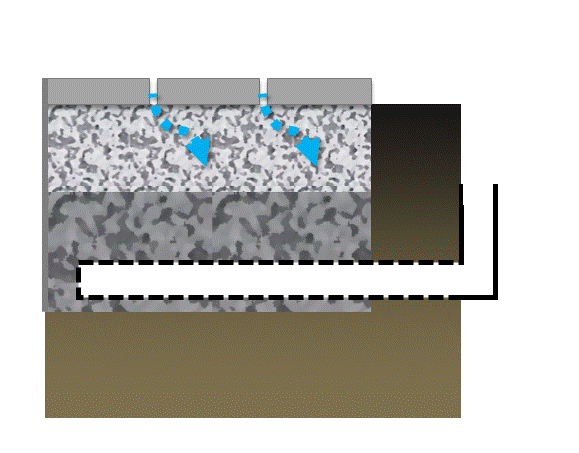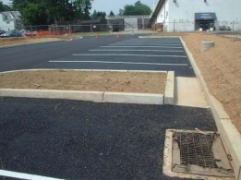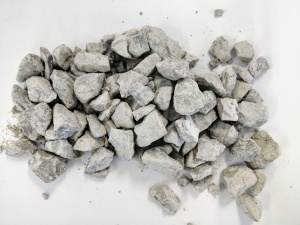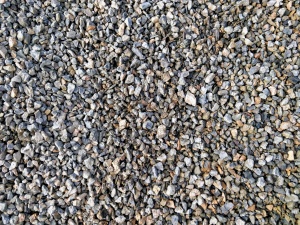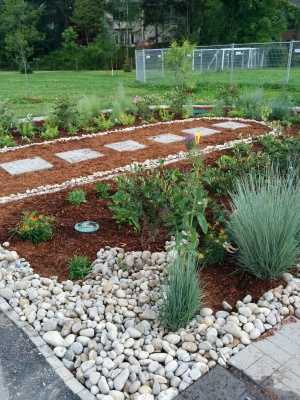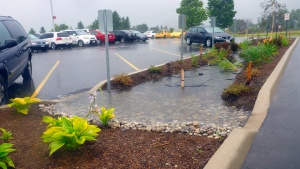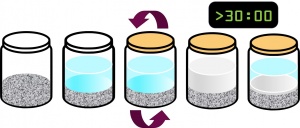Difference between revisions of "Permeable paving"
Jenny Hill (talk | contribs) m |
Kyle menken (talk | contribs) |
||
| Line 1: | Line 1: | ||
[[File:PP IWS.gif|frame|Conceptual diagram illustrating an adjustable storage underdrain configuration beneath permeable interlocking pavers]]{{TOClimit|2}} | [[File:PP IWS.gif|frame|Conceptual diagram illustrating an adjustable storage underdrain configuration beneath permeable interlocking pavers]]{{TOClimit|2}} | ||
==Overview== | ==Overview== | ||
Permeable paving allows stormwater to drain through the surface and into a stone reservoir | Permeable paving allows stormwater to drain through the surface and into a stone reservoir, where it infiltrates into the underlying native soil or is temporarily detained. | ||
<gallery mode="packed"> | <gallery mode="packed"> | ||
PerviousConcreteWalkwayPlaza.png|Pervious Concrete Walkway Plaza | PerviousConcreteWalkwayPlaza.png|Pervious Concrete Walkway Plaza | ||
| Line 9: | Line 9: | ||
* Permeable interlocking concrete pavers | * Permeable interlocking concrete pavers | ||
* Plastic or concrete grid systems | * Plastic or concrete grid systems | ||
* Pervious concrete | * Pervious concrete | ||
* Pervious asphalt | * Pervious asphalt | ||
{{textbox|Permeable paving is ideal for: | {{textbox|Permeable paving is ideal for: | ||
| Line 17: | Line 17: | ||
'''The fundamental components of a permeable paving system are:''' | '''The fundamental components of a permeable paving system are:''' | ||
*interlocking blocks with infiltration spaces between | *interlocking blocks with infiltration spaces between | ||
*Precast pervious slabs or pavers | *Precast pervious slabs or pavers | ||
*a cast in place surface without fines, so that the finish is pervious to water | *a cast in place surface without fines, so that the finish is pervious to water | ||
*a bedding course to stabilize the surface | *a bedding course to stabilize the surface | ||
*underground storage layer of aggregate | *underground storage layer of aggregate | ||
'''Additional components may include:''' | '''Additional components may include:''' | ||
| Line 28: | Line 28: | ||
==Planning considerations== | ==Planning considerations== | ||
<h3>Geometry and Site Layout</h3> | <h3>Geometry and Site Layout</h3> | ||
Permeable paving can be used for entire parking lot areas or driveways | Permeable paving can be used for entire parking lot areas or driveways and can be designed to receive runoff from adjacent impervious surfaces. For example, the parking spaces in a parking lot may be permeable pavers while the drive lanes themsevles are impervious asphalt. | ||
For example, the parking spaces | |||
In general, the impervious area should not exceed 1.2 times the area of the permeable pavement which receives the runoff. | In general, the impervious area should not exceed 1.2 times the area of the permeable pavement which receives the runoff. | ||
A hybrid permeable pavement/soakaway design can feature connection of a roof downspout directly to the stone reservoir of the permeable pavement system, which is sized to store runoff from both the pavement surface and the roof drainage area. | A hybrid permeable pavement/soakaway design can feature connection of a roof downspout directly to the stone reservoir of the permeable pavement system, which is sized to store runoff from both the pavement surface and the roof drainage area. | ||
| Line 40: | Line 40: | ||
<h3>Risk of Groundwater Contamination</h3> | <h3>Risk of Groundwater Contamination</h3> | ||
*Stormwater infiltration practices should not receive runoff from high traffic areas where large amounts of de-icing salts are applied (e.g., busy highways), nor from pollution hot spots (e.g., source areas where land uses or activities have the potential to generate highly contaminated runoff such as vehicle fuelling, servicing or demolition areas, outdoor storage or handling areas for hazardous materials and some heavy industry sites) | *Stormwater infiltration practices should not receive runoff from high traffic areas where large amounts of de-icing salts are applied (e.g., busy highways), nor from pollution hot spots (e.g., source areas where land uses or activities have the potential to generate highly contaminated runoff such as vehicle fuelling, servicing or demolition areas, outdoor storage or handling areas for hazardous materials and some heavy industry sites) | ||
*Prioritize infiltration of runoff from source areas that are comparatively less contaminated such as roofs, low traffic roads and parking areas | *Prioritize infiltration of runoff from source areas that are comparatively less contaminated such as roofs, low traffic roads and parking areas | ||
*Apply sedimentation pretreatment practices (e.g., oil and grit separators) before infiltration of road or parking area runoff | *Apply sedimentation pretreatment practices (e.g., oil and grit separators) before infiltration of road or parking area runoff | ||
<h3>Heavy Vehicle Traffic</h3> | <h3>Heavy Vehicle Traffic</h3> | ||
Permeable pavement is not typically used in locations subject to heavy loads. | Permeable pavement is not typically used in locations subject to heavy loads. However, some permeable pavers are designed for heavy loads and have been used in commercial port loading and storage areas. | ||
<h3>Setbacks from Buildings</h3> | <h3>Setbacks from Buildings</h3> | ||
| Line 51: | Line 51: | ||
<h3>On Private Property</h3> | <h3>On Private Property</h3> | ||
If permeable pavement systems are installed on private lots, property owners or managers will need | If permeable pavement systems are installed on private lots, property owners or managers will need education on their routine maintenance needs, understanding the long-term maintenance plan. They may also be subject to a legally binding maintenance agreement. An incentive program, such as a storm sewer user fee based on the area of impervious cover on a property that is directly connected to a storm sewer, could be used to encourage property owners or managers to maintain existing practices. | ||
==Design== | ==Design== | ||
| Line 61: | Line 61: | ||
===Materials=== | ===Materials=== | ||
Consult the manufacturer for the design specifications of their product. In pervious concrete and porous asphalt systems, the concrete or asphalt mix specifications and construction procedures are key to proper functioning. These systems require well-trained and experienced contractors for installation.<br> | |||
'''[[Permeable paving: Specifications|Specifications]]''' | '''[[Permeable paving: Specifications|Specifications]]''' | ||
Revision as of 20:13, 8 December 2017
Overview[edit]
Permeable paving allows stormwater to drain through the surface and into a stone reservoir, where it infiltrates into the underlying native soil or is temporarily detained.
- PerviousConcreteWalkwayPlaza.png
Pervious Concrete Walkway Plaza
- PermeablePaversinHoboken.png
Permeable Pavers in Hoboken
The following are different types of permeable paving:
- Permeable interlocking concrete pavers
- Plastic or concrete grid systems
- Pervious concrete
- Pervious asphalt
Permeable paving is ideal for:
- Sites with limited space for other surface stormwater BMPs
- Projects such as low traffic roads, parking lots, driveways, pedestrian plazas and walkways
The fundamental components of a permeable paving system are:
- interlocking blocks with infiltration spaces between
- Precast pervious slabs or pavers
- a cast in place surface without fines, so that the finish is pervious to water
- a bedding course to stabilize the surface
- underground storage layer of aggregate
Additional components may include:
- an underdrain system
Planning considerations[edit]
Geometry and Site Layout
Permeable paving can be used for entire parking lot areas or driveways and can be designed to receive runoff from adjacent impervious surfaces. For example, the parking spaces in a parking lot may be permeable pavers while the drive lanes themsevles are impervious asphalt.
In general, the impervious area should not exceed 1.2 times the area of the permeable pavement which receives the runoff. A hybrid permeable pavement/soakaway design can feature connection of a roof downspout directly to the stone reservoir of the permeable pavement system, which is sized to store runoff from both the pavement surface and the roof drainage area.
Pretreatment
In most designs, the surface acts as pretreatment to the stone reservoir below. Periodic vacuum sweeping and preventative measures like not storing snow or other materials on the pavement are critical to prevent clogging. Another pretreatment element is a pea gravel choking layer above the coarse gravel storage reservoir.
Landscaping
Landscaped areas must drain away from permeable pavement to prevent sediments from running onto the surface. Urban trees will benefit from being surrounded by permeable pavement rather than impervious cover, because their roots receive more air and water. Interlocking pavers used around the base of a tree may be removed as the tree grows.
Risk of Groundwater Contamination
- Stormwater infiltration practices should not receive runoff from high traffic areas where large amounts of de-icing salts are applied (e.g., busy highways), nor from pollution hot spots (e.g., source areas where land uses or activities have the potential to generate highly contaminated runoff such as vehicle fuelling, servicing or demolition areas, outdoor storage or handling areas for hazardous materials and some heavy industry sites)
- Prioritize infiltration of runoff from source areas that are comparatively less contaminated such as roofs, low traffic roads and parking areas
- Apply sedimentation pretreatment practices (e.g., oil and grit separators) before infiltration of road or parking area runoff
Heavy Vehicle Traffic
Permeable pavement is not typically used in locations subject to heavy loads. However, some permeable pavers are designed for heavy loads and have been used in commercial port loading and storage areas.
Setbacks from Buildings
Permeable pavement should be located downslope from building foundations. If the pavement does not receive runoff from other surfaces, no setback is required from building foundations. Otherwise, a minimum setback of 4 m down-gradient from building foundations is recommended.
On Private Property
If permeable pavement systems are installed on private lots, property owners or managers will need education on their routine maintenance needs, understanding the long-term maintenance plan. They may also be subject to a legally binding maintenance agreement. An incentive program, such as a storm sewer user fee based on the area of impervious cover on a property that is directly connected to a storm sewer, could be used to encourage property owners or managers to maintain existing practices.
Design[edit]
Modeling permeable paving in the Treatment Train Tool[edit]
Sizing Stone Reservoirs[edit]
Permeable paving: Sizing and modeling
Materials[edit]
Consult the manufacturer for the design specifications of their product. In pervious concrete and porous asphalt systems, the concrete or asphalt mix specifications and construction procedures are key to proper functioning. These systems require well-trained and experienced contractors for installation.
Specifications
Stone Reservoir[edit]
The stone reservoir must meet both runoff storage and structural support requirements. The bottom of the reservoir should be level so that water infiltrates evenly. If the system is not designed for infiltration, the bottom should slope at 1 - 5% toward the underdrain. This is a collection of three articles with the common theme of being aggregate products for various applications in LID.
Underground construction aggregates[edit]
For reservoirs[edit]
This article gives recommendations for aggregate to be used to store water for infiltration. This is usually called 'clear stone' at aggregate yards.
To see an analysis of Ontario Standard Specifications for granular materials, see OPSS aggregates.
For advice on decorative surface aggregates see Stone
Gravel used for underdrains in bioretention, infiltration trenches and chambers, and exfiltration trenches should be 20 or 50 mm, uniformly-graded, clean (maximum wash loss of 0.5%), crushed angular stone that has a porosity of 0.4[1].
The clean wash to prevent rapid accumulation of fines from the aggregate particles in the base of the reservoir. The uniform grading and the angularity are important to maintain pore throats and clear voids between particles. (i.e. achieve the porosity). Porosity and permeability are directly influenced by the size, gradation and angularity of the particles [2]. See jar test for on-site verification testing protocols.
Gravel with structural requirements should also meet the following criteria:
- Minimum durability index of 35
- Maximum abrasion of 10% for 100 revolutions and maximum of 50% for 500 revolutions
Standard specifications for the gradation of aggregates are maintained by ASTM D2940
The highest porosity is found in uniformly graded aggregate, as there are no smaller particles to occupy the inter-particle pores. [2]
Higher permeability is found in larger, angular, uniformly graded aggregate. This is due to larger pore sizes and lower tortuosity. [2]
For choking/choker layers[edit]
In bioretention systems a choker layer of ≥ 100 mm depth is the recommended method to prevent migration of finer filter media into the underlying storage reservoir aggregate. These same mid-sized granular materials are recommended for use in Stormwater planter underdrains and may be useful in the fine grading of foundations courses for permeable pavements.
Suitable materials include:
- High performance bedding (HPB)
- Clean, angular aggregate screened to between 6 and 10 mm. Widely available and designed specifically for drainage applications. Free from fines by definition.
- HL 6
- Is a clean, angular aggregate screened between 10 and 20 mm. Free from fines by definition.
- Pea Gravel
- Rounded natural aggregate, screened between 5 and 15 mm, and washed free from fines.
In most scenarios, a geotextile layer is unnecessary and has been associated with rapid decline and clogging in some circumstances.
OPS Aggregates[edit]
Of the standard granular materials in the standard OPSS.MUNI 1010 only Granular O is recommended as a substitute for clear stone in LID construction.
Where Granular O is substituted for clear stone in underground reservoir structures, the porosity used in design calculations shall be 0.3 unless laboratory testing proves otherwise.
Examples of BMPs with underground reservoirs include Underdrains, infiltration trenches, permeable pavements, infiltration chambers, exfiltration trenches.
All other mixes must be avoided for free drainage or storage as they are permitted to contain a higher enough proportion of fines to reduce permeability below 50 mm/hr.
For more information see OPS aggregates
Landscaping aggregates[edit]
For advice on aggregates used in underdrains, see Reservoir aggregate.
Stone or gravel can serve as a low maintenance decorative feature, but it may also serve many practical functions on the surface of an LID practice.
Stone for erosion control[edit]
Aggregates used to line swales or otherwise dissipate energy (e.g. in forebays) should have high angularity to increase the permissible shear stress applied by the flow of water. [3] However, in some surface landscaped applications there may be a desire to use a rounded aggregate such as 'river rock' for aesthetic reasons. Rounded stones should be of sufficient size to resist being moved by the flow of water. Typical stone for this purpose ranges between 50 mm and 250 mm in diameter. The larger the stone, the more energy dissipation.
- Stone beds should be twice as thick as the largest stone's diameter.
- If the stone bed is underlain by a drainage geotextile, annual inspection and possible replacement should be performed as there is a potential for clogging of this layer to occur.
Stone lining the ponding zone of this rain garden. Image credit California Native Plant Society
Coarse angular stone laid onto a geogrid and geotextile. Image from wikimedia commons
Stone mulch[edit]
Finer inorganic mulch materials can be of value applied in areas with extended ponding times i.e. in the the centre of recessed, bowl shaped bioretention, stormwater planters, trenches or swale practices. Inorganic mulches resist movement from flowing water and do not float. Applying a thin layer of inorganic mulch over the top of wood based mulch has been shown to reduce migration of the underlying layer by around 25% [4]. Inorganic mulches which may be available locally, include:
- Pea gravel
- River rock/beach stone
- Recycled glass
- Crushed mussel shells
On-site verification[edit]
Specifying that aggregates for the construction of LID practices must be free from fines is important. But checking that the delivered materials meet specification is essential to reduce problems with construction and longer term performance.
When possible, Construction Managers should observe the offloading of materials to watch for dust clouds. Aggregates or sand for LID construction should not give rise to clouds of dust when dumped.
A simple jar test can be used to gauge the proportion of fines in an aggregate product before acceptance.
Apparatus:
- A large wide-mouthed jar - glass or clear plastic are both fine,
- Tap water, and
- The aggregate to be tested.
Method:
- Collect approximately 5 cm of material in the jar (or at least two complete layers of 50 mm clear stone),
- Add water to around 3/4 full,
- Secure cap and shake,
- Leave for at least 30 minutes and until the water is clear - plan to run the test overnight when possible,
- Examine the layer of sediment - if > 3 mm has been washed from 5 cm of product, the material should be rejected,
Note that the sediment may collect on top of, or at the bottom of the construction material.
External references[edit]
- Heger, S. (2014). Critical Aspects During System Installation and Inspection General equipment considerations. In PMSA conference. Retrieved from http://www.psma.net/pdf/14/conference-presentations/Keys_to_Installation_(Heger).pdf
- Manitoba. (2010). Onsite Wastewater Management Systems: Field Reference Guide - JAR TEST. Retrieved from http://www.gov.mb.ca/sd/envprograms/wastewater/pdf/jar_test_reference_03_2010.pdf
Geotextile[edit]
See Clogging for notes on their application in LID structures.
Geotextiles can be used to prevent downward migration of smaller particles in to larger aggregates, and slump of heavier particles into finer underlying courses. Geotextiles are commonly used on low strength soils (CBR<4). The formation of biofilm on geotextiles has also been shown to improve water quality:
- By degrading petroleum hydrocarbons[5]
- By reducing organic pollutant and nutrient concentrations [6]
- When installing geotextiles an overlap of 150 - 300 mm should be used.
Material specifications should conform to OPSS 1860 for Class II geotextile fabrics [7]. Note when expansive clays are present, a non-infiltrating design may be necessary. If used, geotextile socks around perforated pipes should conform to ASTM D6707 with minimum water flow rate conforming to ASTM D4491 (12,263 L/min/m2 at 5 cm head).
- Fabrics should be woven monofilament or non-woven needle punched.
- Woven slit film and non-woven heat bonded fabrics should not be used, as they are prone to clogging.
In choosing a product, consider:
- The maximum forces that will be exerted on the fabric (i.e., what tensile, tear and puncture strength ratings are required?),
- The load bearing ratio of the underlying native soil (i.e. is the geotextile needed to prevent downward migration of aggregate into the native soil?),
- The texture (i.e., grain size distribution) of the overlying and underlying materials, and
- The suitable apparent opening size (AOS) for non-woven fabrics, or percent open area (POA) for woven fabrics, to maintain water flow even with sediment and microbial film build-up.
| Percent soil/filter media passing 0.075 mm (#200 sieve) | Non-woven fabric apparent opening size (AOS, mm) | Woven fabric percent open area (POA, %) | Permittivity (sec-1) |
|---|---|---|---|
| >85 | ≤ 0.3 | - | 0.1 |
| 50 - 85 | ≤ 0.3 | ≥ 4 | 0.1 |
| 15 - 50 | ≤ 0.6 | ≥ 4 | 0.2 |
| 5 - 15 | ≤ 0.6 | ≥ 4 | 0.5 |
| ≤ 5 | ≤ 0.6 | ≥ 10 | 0.5 |
Performance research[edit]
http://www.mdpi.com/2073-4441/7/4/1595/htm
Landscaping[edit]
Landscaping plans should reflect the permeable pavement application. Landscaping areas should drain away from permeable pavement to prevent sediments from running onto the surface. Urban trees also benefit from being surrounded by permeable pavement rather than impervious cover, because their roots receive more air and water. Permeable pavers used around the base of a tree can be removed as the tree grows.
Performance[edit]
Permeable pavers can be classified according to the infiltration rate of the underlying subsoil into two categories:
- Full Infiltration: Full infiltration designs are more effective because little if any of the pollutants generated on the impermeable surfaces leave the site as surface runoff.
- Partial Infiltration: Partial infiltration designs with underdrains generate more runoff.
Studies in North Carolina have shown the average curve number of permeable pavements to range from a low of 45 to a high of 89. [8]
Partial infiltration designs with underdrains generate more runoff, and as a result, are often used in studies investigating the water quality impact of permeable pavements on surface waters. These studies show load reductions above 50% for total suspended solids, most metals, and hydrocarbons [9] [10]
As with all stormwater infiltration practices, risk of groundwater contamination from infiltration of runoff laden with road de-icing salt constituents (typically sodium and chloride) is a significant concern. Chloride ions are extremely mobile in the soil and are readily transported by percolating water to aquifers.
Construction Considerations[edit]
Construction of permeable pavement is a specialized project and should involve experienced contractors. The following general recommendations apply:
- Sediment Control: The treatment area should be fully protected during construction so that no sediment reaches the permeable pavement system and proper erosion and sediment controls must be maintained on site.
- Weather: Porous asphalt and pervious concrete will not properly pour and set in extremely high and low temperatures [11]. One benefit to using permeable pavers is that their installation is not weather dependent.
- Pavement placement: Properly installed permeable pavement requires trained and experienced producers and construction contractors.
Inspection and Maintenance[edit]
Permeable pavements require regular inspection and maintenance to ensure that it functions properly. The limiting factor for permeable pavers is clogging within the aggregate layers, filler, or underdrain. Ideally, signs should be posted on the site identifying permeable paver and porous pavement areas. This can also serve as a public awareness and education opportunity. See: Permeable paving: Maintenance
Life Cycle Costs[edit]
Initial construction costs for permeable pavements are typically higher than conventional asphalt pavement surfaces, largely due to thicker aggregate base needed for stormwater storage. However, the cost difference is reduced or eliminated when total life-cycle costs, or the total cost to construct and maintain the pavement over its lifespan, are considered. Other savings and benefits may also be realized, including reduced need for storm sewer pipes and other stormwater practices, less developable land consumed for stormwater treatment, and ancillary benefits such as improved aesthetics and reduced urban heat island effect. These systems are especially cost effective in existing urban development where parking lot expansion is needed, but there is not sufficient space for other types of BMPs. They combine parking, stormwater infiltration, retention, and detention into one facility.
Incentives and Credits [12]
Objective
The key objective of the Stormwater Credit Program is to recognize property owners who have implemented stormwater and/or pollution prevention best management practices (“BMPs”) to reduce impacts to the City’s stormwater infrastructure by controlling the quantity and quality of stormwater leaving their property.
Principles
The Stormwater Credit Program is designed according to the following guiding principles:
- Available to every non-residential and multi-residential property (including those considered “mixed-use”) in Mississauga, unless otherwise exempt from stormwater charges or receiving a subsidy to offset stormwater charges.
- A clear linkage exists between the credit amounts provided and cost savings to the City’s stormwater program resulting from the implementation of BMPs.
- Property owners have the flexibility to pursue practices that suit the needs of and opportunities on their property.
Eligibility
All multi-residential and non-residential properties (including mixed-use properties) are eligible for the credit program, except for any portion thereof which is receiving an exemption or subsidy reduction to the stormwater charge. Single residential properties are not eligible for the credit program.
Credit Schedule
Stormwater credits are available in each of four categories, which align with the overarching objectives of the City’s stormwater program as shown in the following table.
| Category | Evaluation Criteria | Total Credit (50% Maximum) | |
| Peak Flow Reduction | Percent reduction of the 100-year post development flow to pre-development conditions of the site | Up to 40% | To a total of no more than 50% |
| Water Quality Treatment | Consistent with Provincial criteria for enhanced treatment | Up to 10% | |
| Runoff Volume Reduction | Percent capture of first 15 mm of rainfall during a single rainfall event | Up to 15% | |
| Pollution Prevention | Develop and implement a pollution prevention plan | Up to 5% | |
A maximum of 50% credit can be achieved by a property owner or operator. The 50% cap reflects the maximum proportion of the City’s stormwater program in terms of cost that may be beneficially impacted by on-site BMPs. The balance of the City’s program requires funding regardless of BMPs that may be in place on private and public lands.
References[edit]
- ↑ Porosity of Structural Backfill, Tech Sheet #1, Stormtech, Nov 2012, http://www.stormtech.com/download_files/pdf/techsheet1.pdf accessed 16 October 2017
- ↑ Jump up to: 2.0 2.1 2.2 Judge, Aaron, "Measurement of the Hydraulic Conductivity of Gravels Using a Laboratory Permeameter and Silty Sands Using Field Testing with Observation Wells" (2013). Dissertations. 746. http://scholarworks.umass.edu/open_access_dissertations/746
- ↑ Roger T. Kilgore and George K. Cotton, (2005) Design of Roadside Channels with Flexible Linings Hydraulic Engineering Circular Number 15, Third Edition https://www.fhwa.dot.gov/engineering/hydraulics/pubs/05114/05114.pdf
- ↑ Simcock, R and Dando, J. 2013. Mulch specification for stormwater bioretention devices. Prepared by Landcare Research New Zealand Ltd for Auckland Council. Auckland Council technical report, TR2013/056
- ↑ Newman AP, Coupe SJ, Spicer GE, Lynch D, Robinson K. MAINTENANCE OF OIL-DEGRADING PERMEABLE PAVEMENTS: MICROBES, NUTRIENTS AND LONG-TERM WATER QUALITY PROVISION. https://www.icpi.org/sites/default/files/techpapers/1309.pdf. Accessed July 17, 2017.
- ↑ Paul P, Tota-Maharaj K. Laboratory Studies on Granular Filters and Their Relationship to Geotextiles for Stormwater Pollutant Reduction. Water. 2015;7(4):1595-1609. doi:10.3390/w7041595.
- ↑ ONTARIO PROVINCIAL STANDARD SPECIFICATION METRIC OPSS 1860 MATERIAL SPECIFICATION FOR GEOTEXTILES. 2012. http://www.raqsb.mto.gov.on.ca/techpubs/OPS.nsf/0/2ccb9847eb6c56738525808200628de1/$FILE/OPSS%201860%20Apr12.pdf. Accessed July 17, 2017
- ↑ Bean, E.Z., Hunt, W, F., Bidelspach, D.A. 2007a. Evaluation of Four Permeable Pavement Sites in Eastern North Carolina for Runoff Reduction and Water Quality Impacts. Journal of Irrigation and Drainage Engineering. Vol. 133. No. 6. pp. 583-592.
- ↑ Legret, M and V. Colandani. 1999. Effects of a porous pavement structure with a reservoir structure on runoff water: water quality and fate of metals. Water Science and Technology. 39(2): 111-117
- ↑ Pratt, C.J., Mantle, J.D.G., Schofield, P.A. 1995. UK research into the performance of permeable pavement reservoir structures in controlling stormwater discharge quantity and quality. Water Science Technology. Vol. 32. No. 1. pp. 63-69.
- ↑ City of Portland. 2004. Portland Stormwater Management Manual. Prepared by the Bureau of Environmental Services (BES). Portland, OR.
- ↑ http://www7.mississauga.ca/Departments/Marketing/stormwater/stormwater-charge/img/stormwater-credits-manual-0.1.pdf
Proprietary Links[edit]
In our effort to make this guide as functional as possible, we have decided to include proprietary systems and links to manufacturers websites.
Inclusion of such links does not constitute endorsement by the Sustainable Technologies Evaluation Program.
Lists are ordered alphabetically; link updates are welcomed using the form below.
Pre-cast
- Eco-Optioc, Unilock
- Enviro Pavers, Oaks
- Hydropavers pervious pavers
- Pavedrain, distributed by Nilex
- Terra flo, Santerra
- Stormcrete pervious pavers
